The Intel Xeon W-3175X Review: 28 Unlocked Cores, $2999
by Ian Cutress on January 30, 2019 9:00 AM ESTCPU Performance: Encoding Tests
With the rise of streaming, vlogs, and video content as a whole, encoding and transcoding tests are becoming ever more important. Not only are more home users and gamers needing to convert video files into something more manageable, for streaming or archival purposes, but the servers that manage the output also manage around data and log files with compression and decompression. Our encoding tasks are focused around these important scenarios, with input from the community for the best implementation of real-world testing.
All of our benchmark results can also be found in our benchmark engine, Bench.
For our graphs, some of them have two values: a regular value in orange, and one in red called 'Intel Spec'. ASUS offers the option to 'open up' the power and current limits of the chip, so the CPU is still running at the same frequency but is not throttled. Despite Intel saying that they recommend 'Intel Spec', the system they sent to us to test was actually set up with the power limits opened up, and the results they provided for us to compare to internally also correlated with that setting. As a result, we're providing both sets results for our CPU tests.
Handbrake 1.1.0: Streaming and Archival Video Transcoding
A popular open source tool, Handbrake is the anything-to-anything video conversion software that a number of people use as a reference point. The danger is always on version numbers and optimization, for example the latest versions of the software can take advantage of AVX-512 and OpenCL to accelerate certain types of transcoding and algorithms. The version we use here is a pure CPU play, with common transcoding variations.
We have split Handbrake up into several tests, using a Logitech C920 1080p60 native webcam recording (essentially a streamer recording), and convert them into two types of streaming formats and one for archival. The output settings used are:
- 720p60 at 6000 kbps constant bit rate, fast setting, high profile
- 1080p60 at 3500 kbps constant bit rate, faster setting, main profile
- 1080p60 HEVC at 3500 kbps variable bit rate, fast setting, main profile
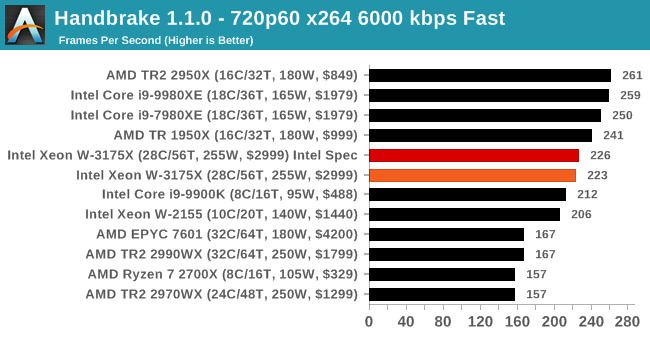
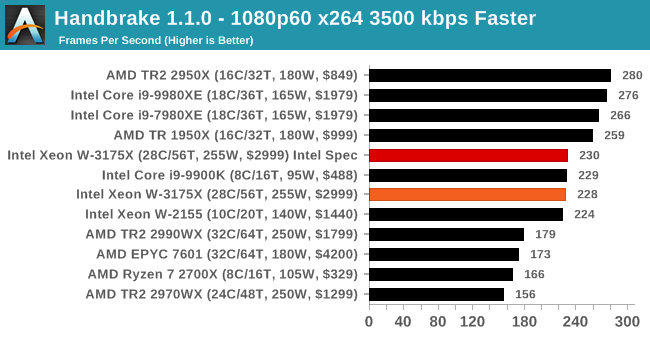
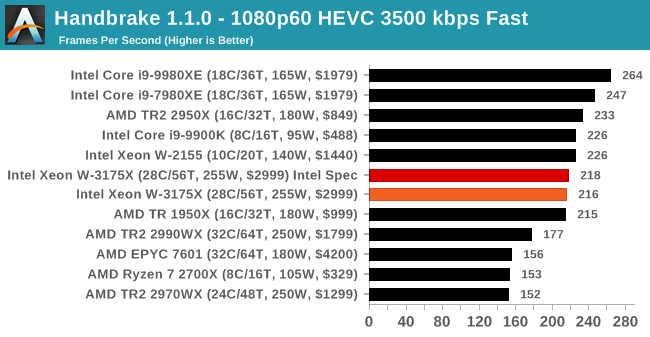
.
7-zip v1805: Popular Open-Source Encoding Engine
Out of our compression/decompression tool tests, 7-zip is the most requested and comes with a built-in benchmark. For our test suite, we’ve pulled the latest version of the software and we run the benchmark from the command line, reporting the compression, decompression, and a combined score.
It is noted in this benchmark that the latest multi-die processors have very bi-modal performance between compression and decompression, performing well in one and badly in the other. There are also discussions around how the Windows Scheduler is implementing every thread. As we get more results, it will be interesting to see how this plays out.
Please note, if you plan to share out the Compression graph, please include the Decompression one. Otherwise you’re only presenting half a picture.
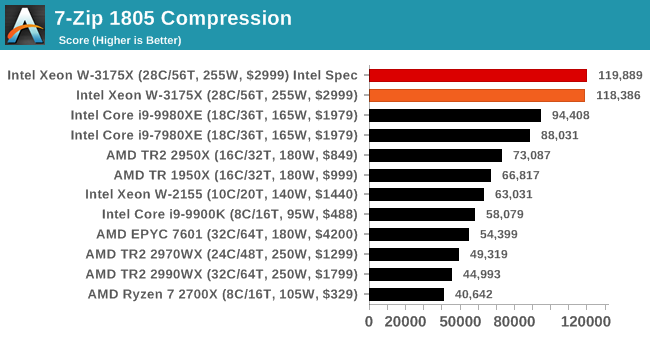
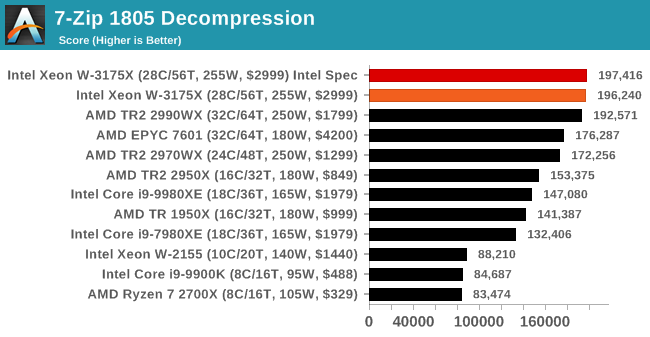
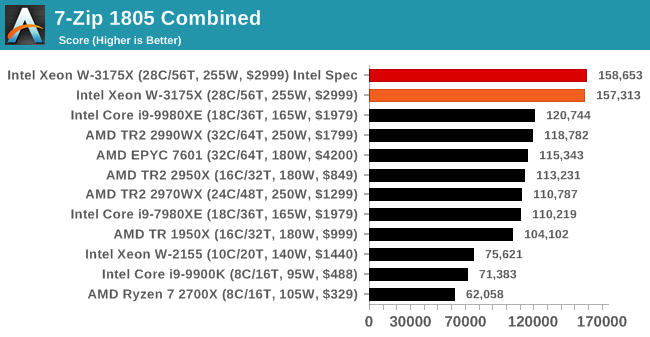
.
WinRAR 5.60b3: Archiving Tool
My compression tool of choice is often WinRAR, having been one of the first tools a number of my generation used over two decades ago. The interface has not changed much, although the integration with Windows right click commands is always a plus. It has no in-built test, so we run a compression over a set directory containing over thirty 60-second video files and 2000 small web-based files at a normal compression rate.
WinRAR is variable threaded but also susceptible to caching, so in our test we run it 10 times and take the average of the last five, leaving the test purely for raw CPU compute performance.
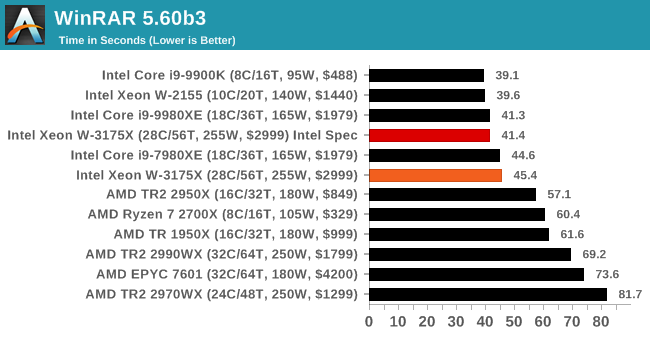
.
AES Encryption: File Security
A number of platforms, particularly mobile devices, are now offering encryption by default with file systems in order to protect the contents. Windows based devices have these options as well, often applied by BitLocker or third-party software. In our AES encryption test, we used the discontinued TrueCrypt for its built-in benchmark, which tests several encryption algorithms directly in memory.
The data we take for this test is the combined AES encrypt/decrypt performance, measured in gigabytes per second. The software does use AES commands for processors that offer hardware selection, however not AVX-512.
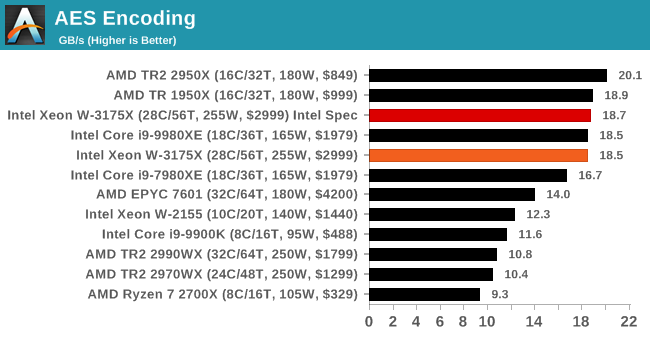
.










136 Comments
View All Comments
tamalero - Wednesday, January 30, 2019 - link
Aaah yes.. the presenter "forgot" to say it was heavily overclocked..arh2o - Wednesday, January 30, 2019 - link
Hey Ian, nice review. But you guys really need to stop testing games with an ancient GTX 1080 from 1H 2016...it's almost 3 years old now. You're clearly GPU bottle-necked on a bunch of these games you've benchmarked. At least use a RTX 2080, but if you're really insistent on keeping the GTX 1080, bench at 720p with it instead of your IGP. For example:Final Fantasy XV: All your CPUs have FPS between 1-4 frames of difference. Easy to spot GPU bottleneck here.
Shadow of War Low: Ditto, all CPUs bench within the 96-100 FPS range. Also, what's the point of even including the medium and high numbers? It's decimal point differences on the FPS, not even a whole number difference. Clearly GPU bottle-necked here even at 1080p unfortunately.
eddman - Wednesday, January 30, 2019 - link
Xeons don't even have an IGP. That IGP in the tables is simply the name they chose for that settings, which includes 720 resolution, since it represents a probable use case for an IGP.Anyway, you are right about the card. They should've used a faster one, although IMO game benchmarks are pointless for such CPUs.
BushLin - Wednesday, January 30, 2019 - link
I'm glad they're using the same card for years so it can be directly compared to previous benchmarks and we can see how performance scales with cores vs clock speed.Mitch89 - Friday, February 1, 2019 - link
That’s a poor rationale, you wouldn’t pair a top-end CPU with an outdated GPU if you were building a system that needs both CPU and GPU performance.SH3200 - Wednesday, January 30, 2019 - link
For all the jokes its getting doesn't the 7290F actually run at a higher TDP using the same socket? Intel couldn't have just have taken the coolers from the Xeon DAP WSes and used those instead?evernessince - Wednesday, January 30, 2019 - link
How is 3K priced right? You can purchased a 2990WX for half that price and 98% of the performance. $1,500 is a lot of extra money in your wallet.GreenReaper - Thursday, January 31, 2019 - link
Maybe they thought since it was called the 2990WX it cost $2990...tygrus - Wednesday, January 30, 2019 - link
1) A few cases showed the 18core Intel CPU beat their 28core. I assume the benchmark and/or OS is contributing to a reduced performance for the 28 core Intel and the 32 core AMD (TR 2950 beats TR 2990 a few times).2) Do you really want to use 60% more power for <25% increase of performance?
3) This chip is a bit like the 1.13GHz race in terms of such a small release & high cost it should be ignored by most of us as a marketing stunt.
GreenReaper - Thursday, January 31, 2019 - link
Fewer cores may be able to boost faster and have less contention for shared resources such as memory bandwidth. This CPU tends to only win by any significant margin when it whenuse all of its cores. Heck, you have the 2700X up there in many cases.